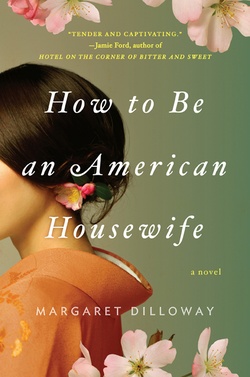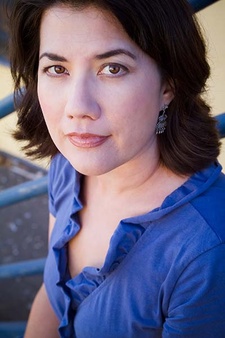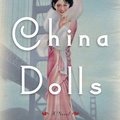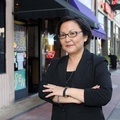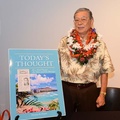Readers may not know what to expect from a novel titled How to Be an American Housewife. Is it actually a novel or a guidebook for American homemakers?
By glancing through “20 Random Things” on author Margaret Dilloway’s website, curious readers will find that the author has a degree in art, severe allergic reactions to grasses, dust, and pollen, and an aversion to handling bacon. She grew up in San Diego, California, the daughter of a Japanese mother and an American father. Although she majored in Studio Art at Scripps College, she claims that she has not “made art” since college, but has always written—no matter what—which is good news for all of her readers.
So, what can readers expect from How to Be an American Housewife? The answer is an incredibly moving and poignant debut novel from Margaret Dilloway.
How to Be an American Housewife is a beautifully woven novel. At its center is the relationship between a Japanese mother, Shoko, who suffers from a heart condition, and her daughter, Sue, a single mother who is raising her own teenage daughter. The novel shifts between the points of view of both women, gradually revealing the painful secrets from Shoko’s past that have weighed on her heart.
Each chapter begins with an excerpt from a guide, “How to Be an American Housewife,” written for Japanese women attempting to adapt to the customs and culture of American life. The guide mirrors the narrative, as it not only moves between narrators but also between Shoko’s past life in Japan and the new life she builds after marrying an American serviceman at the end of World War II. Although she leaves her life in Japan behind, Shoko lives with the hope of some day reconciling with the brother who denies her very existence because of the shame she brought upon her family through her relationship with an Eta, an “untouchable” in Japanese society.
For Sue, Shoko’s daughter, her mother’s quest becomes her own, as she travels to Japan to locate Taro, her mother’s brother, and to fulfill what might be her mother’s dying wish. Like her mother before her, Sue must learn the ways of a country foreign to her, and in doing so, she comes to a deeper understanding of her mother and, more importantly, of herself.
In a recent interview for the Japanese American National Museum’s Discover Nikkei, Margaret Dilloway discussed her own life and the writing of How to Be an American Housewife. Readers will inevitably wonder about the possible parallels between the mother-daughter relationship in the novel and the author’s own relationship with her mother.
Because of the realistic portrayal of this relationship, readers will find it surprising that most of the details are fictional; however, the stories told to Dilloway by her own mother definitely inspired her writing. “My mother was born in the early 1930s in Japan. I grew up hearing a lot of stories about what that was like. Prior to [her death], I had her tape record her life stories. Some of these are included in the book. However, the plot is fiction, and Shoko is not really my mother.
The relationship between Sue and Shoko is similar to the relationship I had with my mother. She would be harsh to me in the interest of helping me out, for example, but it’s also very, very different, not in small part because my own mom died when I was 20, and Sue is in her 30s in the book, and so she develops a different relationship than the one I had. And my mother never got to see her grandchildren, like Shoko does.”
The novel touches on a number of issues important to all generations of Japanese Americans—maintaining one’s cultural identity, staying connected to one’s family, and coming to terms with one’s past. As the daughter of a Japanese mother and American father, Margaret Dilloway, in writing the novel, came to examine these issues in her own life as well.
“Growing up, I never identified as Japanese American. I looked different, but not Asian enough to be considered Japanese and a little bit too exotic or weird (depending on who you talked to) to be white. I didn’t know any other Japanese people besides my mother, and I don’t speak Japanese and my mother refused to teach it. If you grow up not having an extended family to learn your history from, I think it can sometimes leave a hole where you wonder what your place in the world is supposed to be. As an adult, you search for that.”
Dilloway admits that her exploration of the fictional mother-daughter relationship was, at times, both scary and painful. Not surprisingly, readers often find themselves as moved by the subject of her novel as the author was. According to Dilloway, readers have shared a number of memorable reactions to the novel.
“At a recent talk, a reader told me the events in the book largely mirrored her life—her Japanese mother acted a lot like Shoko; she was a single mother like Sue; and she said it was like I had written a book about her. She cried while she told me how much it had moved her and we all started crying. Another reader wrote to me and said she hated her Japanese mother and was about to cut her out of her life forever when she read my book. She said she had never thought about her mother’s experiences, and it shamed her, and so she was going to give her mother my book and take her out to lunch and discuss it.” The author hopes that “the themes of forgiveness and redemption resonate with people.”
Fans of Dilloway’s first novel will be eager to read her next book, The Care and Handling of Roses with Thorns, which is due out in August of 2012. The novel is about “an amateur rose breeder who works as a teacher and struggles with kidney disease. She is close to perfecting a new type of rose when her wayward niece gets dropped into her lap, and she has to restructure her whole life.”
In addition, she is currently working on a novel “that includes a female samurai, Tomoe Gozen, who may or may not have existed.” When her father mentioned that her mother came from a samurai family, Dilloway researched the origins of her family name and discovered that Tomoe Gozen was related the Minamoto family, who were precursors of her mother’s family. The author adds, “Tomoe Gozen was supposedly a stunningly beautiful woman with unparalleled warrior skills—how could you not want to write about her? And the Minamoto story that took place during the Gempei War is absolutely Shakespearean in scope, with lots of familial betrayals.”
Readers who are interested in finding out more about Margaret Dilloway and her writing will have the opportunity to meet the author in her upcoming visit to the Japanese American National Museum on Saturday, February 25, 2012 at 2:00 pm. The event will focus on a discussion about How to Be an American Housewife as well as her other upcoming projects. This opportunity to hear more from the author is not to be missed!
© 2012 Japanese American National Museum


